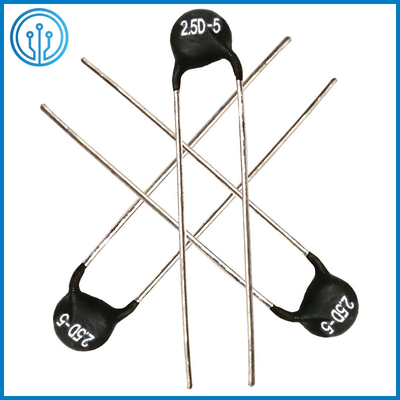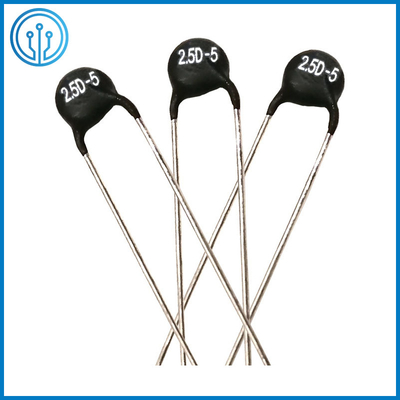PTC And NTC Thermistor 2.5D-5 2.5R 5mm Manufactured By Dongguan Ampfort
Product Details:
| Place of Origin: | DONGGUAN,GUANGDONG,CHINA |
| Brand Name: | AMPFORT |
| Certification: | ROHS |
| Model Number: | 2.5D-5 |
Payment & Shipping Terms:
| Minimum Order Quantity: | 10000PCS |
|---|---|
| Price: | 0.02~0.03USD/PC |
| Packaging Details: | Bulk,1K PER BAG |
| Delivery Time: | 10 workdays |
| Payment Terms: | T/T IN ADVANCE |
| Supply Ability: | 100KKPCS Per month |
|
Detail Information |
|||
| Name: | NTC Thermistor 2.5D-5 | Chip Diameter: | 5mm |
|---|---|---|---|
| R25: | 2.5 Ohm | Color: | Black |
| Resin: | PF | Lead: | CP |
| High Light: | 2.5 Ohm PTC NTC Thermistor,5mm Chip PTC NTC Thermistor,PTC Power NTC Thermistor |
||
Product Description
PTC And NTC Thermistor 2.5D-5 2.5R 5mm Manufactured By Dongguan Ampfort In China
What do the letters and numbers of NTC, MF72, etc. in NTC thermistor MF72-2.5D-5 mean?
(1) NTC refers to negative temperature coefficient thermistor
(2) M means sensitive element
(3) F means negative temperature coefficient
(4) 7 means power type
(5) 2 is the sequence number
(6) 2.5 means the resistance value at 25°C is 2.5 ohms
(7) D5 means the chip diameter is 5mm
What is the difference between PTC and NTC thermistor?
They are available with either a negative temperature coefficient, (NTC) of resistance or a positive temperature coefficient (PTC) of resistance. The difference being that NTC thermistors reduce their resistance as the temperature increases, while PTC thermistors increase their resistance as the temperature increases.
Application Of The PTC And NTC Thermistor
Suitable for switching power supply, switching power supply, UPS power supply, various electric heaters, electronic energy-saving lamps, electronic ballasts, protection of power supply circuits of various electronic devices, and filament protection of color display tubes, incandescent lamps and other lighting fixtures
1.Power products: switch mode power supply,UPS power
2.Lighting products: incandescent lights,energy saving lights,LED lights.
3.Equipment products: industry equipment,communication equipment,electrical equipment,medical equipment
4.Home appliance: air conditioner,refrigerator,TV,washing machine
5.Instrumental products.
Selection Guide Of The PTC And NTC Thermistor
1. Max operating current of ntc thermistor Imax > actual operating current in power circuit.
2. Rated resistance of ntc thermistor R25≥(root of 2)xE/Im
E: Line voltage Im: Max inrush current current in circuit
3. B value is bigger, residual resistance is smaller, temperature rising is smaller when operating.
Features Of The PTC And NTC Thermistor
1. Comply with ROHS complaint
2. Small size,big power,strong inrush current limiting ability
3. Fast response
4. Big B value,low residual resistance
5. Long life and high reliability
6. Completed series,wide operating range
7. Low cost and good stability
Main Parameters Of The PTC And NTC Thermistor
![]()
| P/N | D | T | d | F | L | ||
| Tin-plated copper wire | Tin-plated steel wire | Normal | Cutting | ||||
| MF72 2.5D-5 | ≤7 | ≤4.5 | 0.55±0.06 | 0.5±0.06 | 5.0±1.0 | ≥25 | Customization |
| P/N |
Rated zero power resistance @25C(Ohm) |
Max stable current @25C(A) |
Residual resistance at max current @25C(A) |
B25/85(K) | Thermal time constant(s) | Dissipation factor(mw/C) | Certification | Operating temperature |
| MF72 2.5D-5 | 2.5 | 0.7 | 0.4 | 2700 | ≤18 | ≥6 | -40~150 | UL |
Series Parameters Of The PTC And NTC Thermistor
| P/N |
Rated zero power resistance @25C(Ohm) |
Max stable current @25C(A) |
Residual resistance at max current @25C(A) |
B25/85(K) | Thermal time constant(s) | Dissipation factor(mw/C) | Certification | Operating temperature |
| 5D-5 | 5 | 1 | 0.584 | 2700 | ≤18 | ≥6 | -40~150 | CQC UL CUL TUV |
| 6D-5 | 6 | 0.7 | 0.675 | 2700 | ≥6 | -40~150 | TUV | |
| 7D-5 | 7 | 0.7 | 0.766 | 2700 | ≥6 | -40~150 | TUV | |
| 8D-5 | 5 | 0.7 | 0.857 | 2700 | ≥6 | -40~150 | TUV | |
| 10D-5 | 10 | 0.7 | 1.039 | 2700 | ≥6 | -40~150 | CQC UL CUL TUV | |
| 12D-5 | 12 | 0.6 | 1.235 | 2800 | ≥6 | -40~150 | TUV | |
| 15D-5 | 15 | 0.6 | 1.530 | 2800 | ≥6 | -40~150 | CQC UL CUL TUV | |
| 16D-5 | 16 | 0.6 | 1.628 | 2800 | ≥6 | -40~150 | TUV | |
| 18D-5 | 18 | 0.6 | 1.824 | 2800 | ≥6 | -40~150 | TUV | |
| 20D-5 | 20 | 0.6 | 2.020 | 2800 | ≥6 | -40~150 | CQC UL CUL TUV | |
| 22D-5 | 22 | 0.6 | 2.060 | 2800 | ≥6 | -40~150 | CQC UL CUL TUV | |
| 25D-5 | 25 | 0.5 | 2.123 | 2800 | ≥6 | -40~150 | TUV | |
| 30D-5 | 30 | 0.5 | 2.227 | 2800 | ≥6 | -40~150 | CQC UL CUL TUV | |
| 33D-5 | 33 | 0.5 | 2.436 | 2800 | ≥6 | -40~150 | CQC UL CUL TUV | |
| 50D-5 | 50 | 0.4 | 2.653 | 3000 | ≥6 | -40~150 | CQC UL CUL TUV | |
| 60D-5 | 60 | 0.3 | 2.753 | 3000 | ≥6 | -40~150 | CQC UL CUL TUV | |
| 200D-5 | 200 | 0.1 | 18.7 | 3000 | ≥6 | -40~150 | UL |
![]()
![]()
![]()
![]()
Why can't products using NTC thermistors switch frequently? The following is their brief analysis and improvement.
a.Briefly analyze
We can see from the analysis of the working principle of the circuit that there are products that use NTC thermistors. Under normal working conditions, a certain current flows through the NTC thermistor, and this working current is enough to make the surface temperature of the NTC reach 100 ℃~200℃. When the product is turned off, the NTC thermistor must fully recover from the high temperature and low resistance state to the normal temperature and high resistance state in order to achieve the same surge suppression effect as the last time. This recovery time is related to the dissipation coefficient and heat capacity of the NTC thermistor, and the cooling time constant is generally used as a reference in engineering. The so-called cooling time constant refers to the time (in seconds) required for the NTC thermistor to cool down to 63.2% of its temperature rise after self-heating in a specified medium. The cooling time constant is not the time required for the NTC thermistor to return to normal, but the larger the cooling time constant, the longer the required recovery time, and vice versa.
b.how to improve
Under the guidance of the above ideas, at the moment when the product is powered on, the NTC thermistor suppresses the inrush current to an appropriate level, and then the product is powered on and works normally. Resistors are cut from the working circuit. In this way, the NTC thermistor only works when the product is started, and is not connected to the circuit when the product is working normally. This not only prolongs the service life of the NTC thermistor, but also ensures that it has sufficient cooling time, which can be suitable for applications requiring frequent switching.
It can be seen from the above analysis that for applications that require frequent switching, a relay bypass circuit must be added to the circuit to ensure that the NTC thermistor can be completely cooled and returned to the resistance in the initial state. In product selection, the product series should be selected according to the maximum rated voltage and filter capacitance value, and the resistance value of the NTC thermistor should be selected according to the maximum starting current value allowed by the product and the working current loaded on the NTC thermistor for a long time. At the same time, the temperature of the working environment should be considered, and the derating design should be appropriately carried out.
c. in conclusion
It can be seen from the above analysis that the NTC thermistor type surge suppressor used in the power supply design has the same ability to suppress the surge current as the ordinary resistor, and the power consumption on the resistor can be reduced by tens to hundreds of times. For applications that require frequent switching, a relay bypass circuit must be added to the circuit to ensure that the NTC thermistor can completely cool down and return to its initial state of resistance. In product selection, the product series should be selected according to the maximum rated voltage and filter capacitance value, and the resistance value of the NTC thermistor should be selected according to the maximum starting current value allowed by the product and the working current loaded on the NTC thermistor for a long time. At the same time, the temperature of the working environment should be considered, and the derating design should be appropriately carried out.










